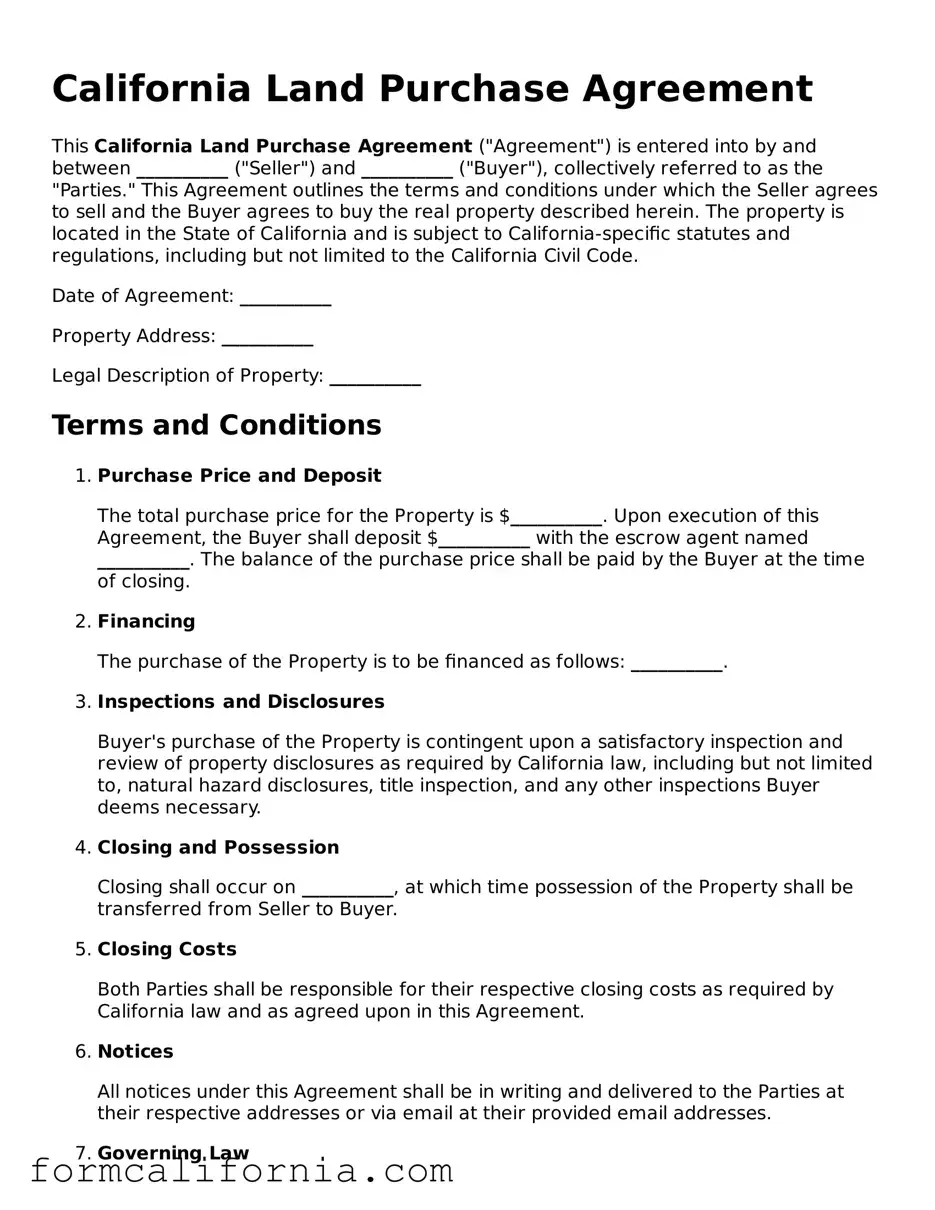The California Land Purchase Agreement form is closely related to a Residential Purchase Agreement. Both documents serve as binding contracts between buyers and sellers, specifying the terms, conditions, and particulars of property transactions. While the Land Purchase Agreement focuses on the sale of undeveloped land, a Residential Purchase Agreement is used for transactions involving residential properties. They detail critical elements like purchase price, deposit amounts, inspection rights, and closing conditions, ensuring all parties understand their commitments.
Another similar document is the Real Estate Purchase Contract. This contract is a broader term encompassing the sale and purchase of real estate property, which may include land, residential homes, or commercial properties. It outlines the responsibilities of each party, financial details, and any contingencies that must be met before the sale is finalized. Like the Land Purchase Agreement, it is legally binding once signed by both the buyer and the seller.
The Option to Purchase Agreement shares similarities with the Land Purchase Agreement but includes a unique feature: it gives the buyer the right, but not the obligation, to purchase the property within a specified period. This agreement is often used by investors or buyers who need time to arrange financing or perform due diligence before committing to the purchase. It includes a fee for this option, and terms similar to a standard purchase agreement regarding price and conditions.
A Quitclaim Deed, while different in purpose, relates to the Land Purchase Agreement as it is often used in tandem with the sale of land to transfer any remaining interest the seller has in the property to the buyer. Unlike the Land Purchase Agreement, a Quitclaim Deed does not guarantee the seller’s ownership or title status – it simply transfers whatever ownership the seller has, if any, to the buyer.
An Earnest Money Agreement is a component often found within a Land Purchase Agreement or any real estate transaction. It requires the buyer to deposit a certain amount of money as a sign of good faith, indicating their serious intention to complete the purchase. This document outlines the amount, the holder of these funds, and conditions under which the deposit may be returned to the buyer or forfeited to the seller.
The Joint Tenancy Agreement, though specifically a title-holding and co-ownership arrangement, bears relevance to land purchase transactions. It defines the rights of each co-owner to land or real estate purchased together. This includes rights to use, profits from, or responsibilities for the property. In a land purchase, understanding how co-ownership is structured is vital for all parties involved.
A Land Lease Agreement, conversely, is about the rights to use land rather than purchase it. Similar to the Land Purchase Agreement in its structure and detail orientation, it outlines terms for leasing land, such as duration, payment, and rights of use, but does not transfer ownership. It’s relevant for buyers looking to use land without the immediate intention to buy.
The Construction Agreement is also akin to the Land Purchase Agreement when buying land for development purposes. It outlines the terms under which construction will occur on the purchased land, including timelines, costs, and specifications. Although focused on the build process post-purchase, the agreements must often align, as construction plans can affect land value and usability.
Finally, the Seller Financing Agreement has similarities with the Land Purchase Agreement, especially when the seller agrees to finance the buyer’s purchase of the land. This document specifies terms of the loan provided by the seller, including repayment schedule, interest rates, and consequences of default. It’s crucial for facilitating transactions where traditional financing options are not available or preferred by the buyer.
An Escrow Agreement is an essential adjunct to a Land Purchase Agreement, ensuring that all the conditions agreed upon by both parties are met before funds and property change hands. It involves a third party holding the buyer's funds and the property title until all agreement terms are satisfied, thereby providing a layer of protection and confidence to both the buyer and the seller during the transaction process.
